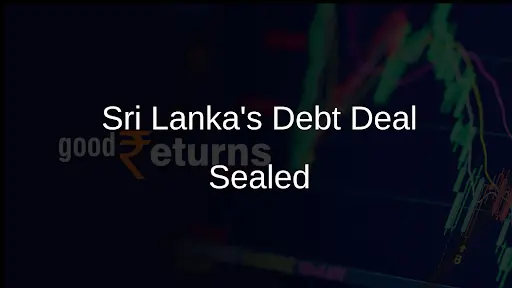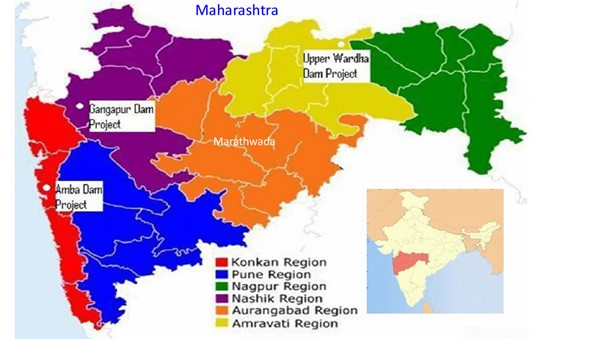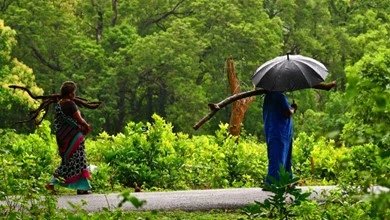Monday, 1st July 2024
RBI raises WMA limits of States/UTs
Why in the news?
- The Reserve Bank of India (RBI) has raised the Ways and Means Advances (WMA) limits for State governments and Union territories from ₹47,010 crore to ₹60,118 crore.
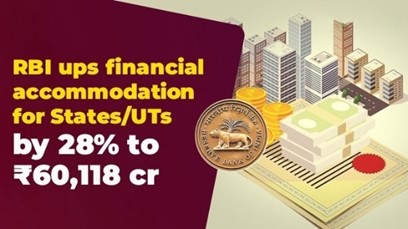
- This decision is based on recommendations from a group formed by the Reserve Bank, which included some state Finance Secretaries, and after reviewing the states' recent spending data. The increase will take effect from July 1, 2024.
- The RBI also mentioned that the Special Drawing Facility (SDF) availed by State Governments/ UTs will continue to be linked to the quantum of their investments in marketable securities, including Auction Treasury Bills (ATBs).
About the Special Drawing Facility (SDF):
- SDF is a short-term borrowing arrangement provided by RBI to state governments and Union Territories (UTs).
- This facility helps manage temporary mismatches in cash flows, similar to the Ways and Means Advances (WMA) but with different terms and conditions.
- SDF is provided against the collateral of government securities held by the state governments or Union Territories.
- The amount available under SDF is directly linked to the value of these securities.
About the Auction Treasury Bills:
- Auction Treasury Bills (T-Bills) are short-term debt instruments issued by the government to meet its immediate financial needs.
- They are sold through a competitive bidding process, also known as an auction, conducted by RBI on behalf of the government.
Ways and Means Advances (WMA):
- About:
- WMA are temporary loan facilities provided by the RBI to the central and state governments to manage temporary mismatches in their receipts and expenditures.
- These borrowings are meant to help manage temporary mismatches in cash flows of their receipts and expenditures.
- The WMA scheme was introduced on April 1, 1997.
- Legal Provision:
- Section 17(5) of the RBI Act, 1934 authorises the central bank to lend to the Centre and state governments, provided the advances are repayable “not later than three months from the date of the making of the advance”.
- Types:
- Normal WMA: A fixed limit is set, and borrowing within this limit is charged at the repo rate.
- Special WMA or Special Drawing Facility: Additional borrowing over and above the normal WMA, backed by government securities held by the state government.
- After the state exhausts the limit of SDF, it gets normal WMA.
Key Features:
- Duration: The advances are typically short-term, with a duration of up to 90 days. If the amount is not returned within this period, it would be treated as an overdraft. The interest rate on overdrafts is 2 percentage points more than the repo rate.
- Interest Rates: Interest rates on WMA are linked to the repo rate.
- For Normal WMA: interest rate = repo rate
- For Special WMA: interest rate = one percentage point less than the repo rate
- For overdraft: interest rate = 2 percentage points more than the repo rate
- Limits: The RBI, in consultation with the government, sets limits for WMA for both the central and state governments. These limits are reviewed periodically.
- Number of Loans: Number of loans under normal WMA is based on a three-year average of actual revenue and capital expenditure of the state.
Benefits of WMA:
- Liquidity Management: Helps the government manage its day-to-day liquidity requirements, ensuring that short-term cash flow mismatches do not disrupt essential spending.
- Fiscal Discipline: Encourages better fiscal management as the governments are expected to repay the advances within a stipulated period, promoting timely receipt and disbursement of funds.
- Interest Cost Savings: The interest rate on WMA is typically lower than market borrowing rates, reducing the interest burden on the government.
- Flexible Funding: Provides a flexible source of funds for immediate and unforeseen expenditures without having to resort to market borrowings, which might be time-consuming and more expensive.
- Market Stability: By avoiding sudden large borrowings from the market, WMA helps in maintaining stability in the government securities market.
Limitations and Risks:
- Short-Term Solution: WMA is only a short-term solution and cannot be relied upon for long-term fiscal issues.
- Repayment Pressure: The need to repay within a short period might create additional pressure on the government’s finances.
- Interest Costs: While the interest rate is lower than market borrowings, prolonged use of WMA can still add to the interest burden if not managed properly.
Source: TH
India Achieves ‘Outstanding Outcome’ FATF Mutual Evaluation
Why in the News?
- India has achieved an outstanding outcome in the Mutual Evaluation conducted during 2023-24 by the Financial Action Task Force (FATF).
- The Mutual Evaluation Report of India, which was adopted in the FATF plenary held in Singapore recently, places India in the “regular follow-up” category, a distinction shared by only four other G-20 countries.
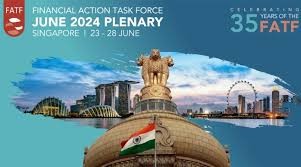
About Financial Action Task Force (FATF):
- History: The Financial Action Task Force (FATF) is an intergovernmental organisation founded in 1989. It is an initiative of the G7 countries to develop policies to combat money laundering. In 2001, its mandate was expanded to include terrorism financing. It has also started dealing with virtual currencies.
- Objectives: FATF sets international standards to prevent money laundering (ML) and terrorism financing (TF), and the harm they cause to society. It is a policy-making body that generates political will to bring about national legislative and regulatory reforms.
- Members: The FATF currently comprises 38 member jurisdictions and two regional organisations, representing most major financial centres globally. India became an Observer at FATF in 2006 and was taken in as the 34th country member in 2010.
- Mutual Evaluation Process:
- Evaluation Team: A team of experts from FATF member countries conducts the evaluation, analysing the country's measures and their effectiveness in preventing ML and TF.
- Assessment Criteria: Based on FATF's 40 Recommendations, covering preventive measures, criminal justice, law enforcement, and international cooperation.
- Technical Compliance: Assesses whether the country's legal and institutional frameworks align with FATF standards.
- Effectiveness: Measures how well the country implements and enforces its laws and regulations, and achieves desired outcomes in combating ML and TF.
- Country Reports: Findings are compiled into a Mutual Evaluation Report, providing a detailed analysis of compliance and effectiveness with ratings and recommendations for improvement.
- Follow-Up: Countries may be placed in follow-up processes to address deficiencies, involving periodic reporting to FATF on progress.
- Public Disclosure: The Mutual Evaluation Report is published, providing transparency and encouraging enhancements to AML/CFT (Anti-Money Laundering/Countering the Financing of Terrorism) regimes.
India Achieves an ‘Outstanding Outcome’ in FATF Mutual Evaluation
- India has achieved a remarkable outcome in the 2023-24 Mutual Evaluation by FATF, placing it in the “regular follow-up” category.
- This signifies a high level of compliance in combating ML and TF, though some non-financial sectors require improvement in supervision and preventive measures.
- FATF highlighted India's success in mitigating ML/TF risks through digital economy initiatives like the JAM Trinity (Jan Dhan, Aadhaar, Mobile) and stringent cash transaction regulations.
- This evaluation enhances India's financial stability and integrity, boosting access to global financial markets and investor confidence, and supporting the expansion of the Unified Payments Interface (UPI).
Government’s Response
- India's recognition by FATF reflects the country's effective measures over the past decade to protect its financial system from ML and TF threats.
- This achievement underscores India's commitment to international standards and enhances its capacity to lead global efforts against financial crimes.
- Since 2014, the government has enacted legislative changes and bolstered enforcement efforts, aligning with international standards and yielding positive results, including disrupting terror funding networks.
- The Department of Revenue led India's engagement with FATF, supported by a diverse team from various sectors, showcasing the country's comprehensive approach to combating ML and TF.
|
UPSC Civil Services Examination, Previous Year Questions (PYQs) Mains Q:1 Discuss how emerging technologies and globalisation contribute to money laundering. Elaborate measures to tackle the problem of money laundering both at national and international levels. (2021) Q:2 Analyse the complexity and intensity of terrorism, its causes, linkages and obnoxious nexus. Also suggest measures required to be taken to eradicate the menace of terrorism. (2021) |
Source:TH
The NTA Failed to Deliver
Why in the news?
- With widespread allegations of cheating, paper leaks, and other irregularities impacting flagship examinations such as the NEET (National Eligibility cum Entrance Test), the National Testing Agency (NTA) has come under intense scrutiny.

The National Testing Agency (NTA):
- Background:
- In 2010, a committee comprising directors of IITs recommended establishing an autonomous and transparent body (NTA) through legislation, modelled after the Educational Testing Service (ETS) of the US.
- Before the NTA’s formation, various government bodies like the UGC, the CBSE, and central universities such as Delhi University and JNU conducted their own entrance examinations.
- About NTA:
- It was set up in 2017 as a specialist, self-sustaining, and autonomous organisation under the aegis of the Union Ministry of Education.
- It is registered under the Societies Registration Act 1860 and falls under the Right to Information (RTI) Act.
- Objectives:
- To address the challenges of assessing candidates’ competence by adhering to international standards, ensuring efficiency, transparency, and error-free delivery.
- To conduct efficient and transparent tests, research and development, expert collaboration, and information dissemination.
- Examinations conducted by the NTA:
- JEE (Main), NEET-UG, Common Management Admission Test (CMAT), Graduate Pharmacy Aptitude Test (GPAT), and University Grants Commission-National Eligibility Test (UGC-NET).
- The National Education Policy 2020 envisaged a broader role, recommending that the NTA conduct an entrance or aptitude test for all universities across the country.
- In all, the NTA now handles more than 20 examinations.
Who runs the NTA?
- Its director general and governing body are appointed by the Union government.
- The core team of the NTA consists of test item writers, researchers, psychometricians, and education specialists.
- The NTA operates six verticals, each focusing on different examinations, employing about six researchers each, including internationally recognized experts in psychometrics and statistics.
Issues Faced by the NTA:
- Conduct computer-based tests only:
- This ensures that high volume can be processed in a short period.
- As the NIC (National Informatics Centre) does not have the capacity or IT infrastructure needed, third-party technical partners are engaged.
- However, third-party involvement takes accountability out of the government’s hands and leaves loopholes in the system that can be exploited by unscrupulous players.
- Agency is severely understaffed:
- The agency was set up with only about 25 permanent staff positions, with functions outsourced to technical partners from the beginning.
- Absence of robust security mechanisms:
- Needed to handle large-scale pen-and-paper examinations, including:
- Setting the question paper and its encryption,
- Selection of external printing presses and exam centres,
- Transportation to printing presses,
- Storage and distribution to examinees at examination centres,
- Collection and transportation of answer sheets to evaluation centres.
- Each stage is vulnerable to malpractice without robust security mechanisms.
- NEET and UGC-NET exams irregularities:
- The NTA faced severe criticism after awarding grace marks to 1,563 candidates in the NEET exam due to delays at seven examination centres, leading to accusations of inflated marks and a record 67 candidates sharing the top rank.
- The integrity of NEET-UG was further compromised when the exam question paper was allegedly leaked.
- Similarly, the UGC-NET exam was cancelled a day after being conducted, following reports that its integrity had been breached.
What Needs to be Done to Reform India’s Examination Process?
- Radhakrishnan committee:
- A high-level panel headed by former ISRO chief K. Radhakrishnan has been constituted to recommend:
- Reforms in the examination process,
- Improved data security protocols,
- An overhaul of the NTA’s functioning.
- Adding manpower and infrastructure to the NTA:
- Equip it to take on large-scale pen-and-paper examinations, which are more equitable, especially for students in rural and remote areas with little access to technology.
- Dismantling the centralization process:
- More decentralised structures are needed to meet the vastly differing needs of institutions.
- More radical reform of the assessment system:
- Includes periodic assessments of knowledge,
- Concept-based understanding, and
- Aptitude can be included in the final years of school education as the precursor to the admission process.
|
UPSC Civil Services Examination, Previous Year Question (PYQ) Prelims Q:1 Which of the following provisions of the Constitution does India have a bearing on Education? (2012)
Select the correct answer using the codes given below: (a) 1 and 2 only (b) 3, 4 and 5 only (c) 1, 2 and 5 only (d) 1, 2, 3, 4 and 5 Ans: D
Mains Q:1 How have digital initiatives in India contributed to the functioning of the education system in the country? Elaborate on your answer. (2020)
|
Source: TH
Tussle over Covaxin IPR
Why in the News?
- Bharat Biotech International Limited (BBIL), the company that created the Indian coronavirus vaccine Covaxin, has admitted to making an unintended mistake in its patent filings.
- These filings are meant to protect the vaccine’s Intellectual Property Rights (IPR).
- Despite being one of India's top biotechnology companies, BBIL forgot to list the scientists from the Indian Council of Medical Research (ICMR) as co-inventors in the patent documents for Covaxin.

What are Patents and IPR?
- Patents:
- A patent represents a powerful Intellectual Property Right (IPR) and is an exclusive monopoly granted by a Government to an inventor for a limited, pre-specified time.
- It provides an enforceable legal right to prevent others from copying the invention.
- Types of Patents:
- Product Patent: Protects the rights to the final product, restraining others from manufacturing it during a specified period.
- Process Patent: Allows others to manufacture the patented product by modifying certain processes in the manufacturing exercise.
- India's Patent Regime:
- Initially adopted process patenting in the 1970s, enabling India to become a significant producer of generic drugs on a global scale.
- Due to the obligations under the TRIPS (Trade-Related Aspects of Intellectual Property Rights) Agreement, product patenting is also allowed in India.
- TRIPS is an international legal agreement between all member nations of the World Trade Organization (WTO).
Controversy Surrounding the Covaxin IPR:
- Details:
- BBIL patented the process of making vaccines from virus strains provided by the ICMR-NIV (National Institute of Virology).
- The ICMR-NIV specialises in extracting viruses from blood samples, identifying their characteristics, conducting tests to measure their infectiousness, and comparing them to related strains.
- Turning this research into a vaccine on an industrial scale requires facilities that only established vaccine manufacturers have.
- Covaxin Development:
- Covaxin, developed by BBIL, is an inactivated version of the coronavirus that causes COVID-19.
- When injected, it stimulates the body to produce antibodies that may protect against severe illness from the virus.
- An adjuvant is added to the vaccine to enhance its effectiveness.
- Vaccine manufacturers have their own methods for combining these steps and aim to prevent others from copying their processes to maintain a temporary monopoly and earn profits.
- Patent Application:
- Companies can apply for product or process patents in as many countries as they can afford.
- A patent is only granted after regulatory authorities are convinced that the process is indeed novel or inventive.
- As of now, Bharat Biotech has not yet been granted these patents.
What were the Roles of BBIL and ICMR?
- Collaboration:
- BBIL collaborated with ICMR-NIV on every step of developing the Covaxin vaccine, signing an agreement outlining each organisation's responsibilities.
- Due to ICMR being a public entity and the scale of the COVID crisis, there were requests to make this agreement public under the Right to Information Act. Portions of the agreement were revealed in the Rajya Sabha in July 2021.
- Responsibilities:
- ICMR provided virus strains, tested the vaccines on animals and humans, and funded clinical trials with ₹35 crore, incurring costs in developing Covaxin.
- ICMR was to receive 5% of the royalties BBIL earned from the sale of Covaxin.
- Intellectual Property Rights:
- It was generally understood that both entities would share the intellectual property rights.
- Initially, BBIL claimed a distinction between the rights to make the vaccine and the rights to the data from clinical trials, stating that ICMR was not included in the patent applications due to not investing in the actual production of the vaccine.
- Following public scrutiny, BBIL admitted to an error and announced plans to file new applications listing ICMR personnel as co-inventors.
Conclusion:
- IPR Complexity:
- IPR covers all aspects of product invention and is a complex field.
- Developing pharmaceutical products requires various types of expertise, making it difficult for single firms to handle everything alone.
- Companies often enter into multiple licensing agreements, as BBIL did with Virovax for an adjuvant.
- Collaborative Efforts:
- When multiple entities collaborate on a single product, being listed as an inventor affects the sharing of IPR, royalties, and product usage.
- Disputes over IPR are common across all fields. In patent filings, especially in the U.S., not listing all inventors can result in patent application rejections.
Source: TH
Delay in the Teesta Water Sharing Treaty
Why in the news?
- During the recent state visit of Bangladesh Prime Minister Sheikh Hasina to India, PM Modi announced that a technical team would soon visit Bangladesh to discuss the conservation and management of the Teesta River.
- This remark has reignited speculation about the long-pending Teesta water sharing treaty, a crucial bilateral agreement that has remained unresolved for over a decade.
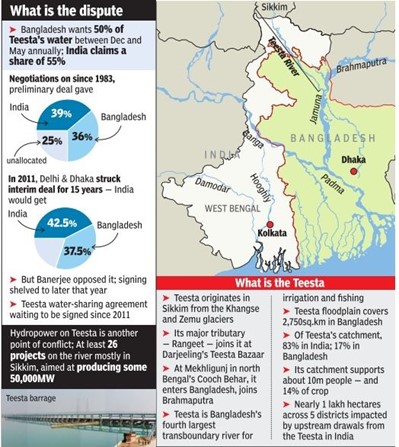
About the Teesta River:
- About:
- The Teesta River is a tributary of the Jamuna River (Brahmaputra River) and flows through India and Bangladesh.
- Origin and Course:
- Originates from the Tso Lhamo Lake at an elevation of about 5,280 metres in north Sikkim.
- Flows south, cutting a deep gorge through the Siwalik Hills east of Darjeeling (in West Bengal, India), and turns southeast to run through the Sivok Khola pass onto the plains of West Bengal.
- Enters Bangladesh in the Rangpur Division, eventually merging with the Brahmaputra River.
- Countries:
- India: Sikkim and West Bengal
- Bangladesh: Rangpur Division
- Major Tributaries:
- Left-bank Tributaries: Lachung Chhu, Chakung Chhu, Dik Chhu, Rani Khola, Rangpo Chhu.
- Right-bank Tributaries: Zemu Chhu, Rangyong Chhu, Rangit River.
- Significance for India and Bangladesh:
- Teesta is Bangladesh’s fourth largest trans-boundary river and its floodplain covers an area of 2,750 square kilometres in Bangladesh.
- 83% of the river’s catchment area lies in India, supporting 8.5% of its population and 14% of its crop production.
What is the Teesta Water Sharing Proposal ?
2011 Proposal:
- Water Distribution:
- Proposed an equitable distribution of the Teesta River's water between India and Bangladesh.
- India was to receive 42.5% and Bangladesh 37.5% of the river's water flow during the lean season (December to March).
- Remaining water would be managed according to seasonal variations and mutual needs.
- Collaborative Management:
- Included provisions for joint monitoring and management of the river’s water.
What are the controversies Surrounding the Proposal ?
- West Bengal’s Opposition:
- Opposition from the Indian state of West Bengal is the chief obstacle to the treaty's finalisation.
- Concerns that the proposed water sharing would adversely affect West Bengal's irrigation and drinking water needs.
- Significant dependence on the Teesta River for its agriculture sector adds to the reluctance to agree to the terms.
- Regional Politics:
- The issue is deeply entangled in regional politics.
- The West Bengal government's refusal to endorse the agreement reflects broader political dynamics and sensitivities, where state interests are sometimes prioritised over national diplomatic commitments.
- Environmental Concerns:
- Environmentalists in both countries have raised concerns about the potential ecological impacts of altering the river's flow.
- Construction of dams and barrages as part of the management strategy could disrupt the river’s ecosystem and negatively affect biodiversity.
- A glacial lake outburst in October 2023 triggered floods in the Teesta basin, claiming lives and destroying the Teesta III hydroelectric dam.
- Bangladesh’s Dependence:
- Heavily relies on the Teesta River, especially in the northern region, for agriculture and livelihood.
- Faces significant water shortages during the dry season, exacerbating the need for a fair and reliable water-sharing agreement.
- The perception that Bangladesh has historically received less than its fair share of water has fueled public sentiment and political pressure to secure a favourable deal.
- Previous Agreements and Trust Deficit:
- Historical water-sharing disputes, such as those involving the Ganges River, have led to a trust deficit between the two countries.
- Past experiences influence the current dialogue and expectations.
- Other Issues:
- Dams for hydro-electric power generation in Sikkim and the Teesta Barrage Project at Gazoldoba in West Bengal make the flow of the river erratic in Bangladesh, leading to either floods or scarcity of water.
- China’s Interference:
- In 2020, China proposed major dredging work on the Teesta River and building reservoirs and embankments.
- The Bangladesh government has put the proposal on hold for the past four years.
Why is Bengal Talking about the Ganga Treaty?
- Ganga Treaty Renewal:
- The Ganga water sharing treaty with Bangladesh completes 30 years in 2026 and a renewal of the agreement is on the cards.
- Signed in 1996, it ensures equitable water sharing of the Ganges River.
- Water allocation during the dry season (January to May):
- India: Receives a minimum of 35,000 cubic feet per second (cusecs) of water at Farakka.
- Bangladesh: Receives a minimum of 35,000 cusecs of water at Farakka.
- West Bengal’s Concerns:
- Points out that water sharing with Bangladesh has changed the Ganga’s morphology and affected lakhs of people in West Bengal due to river erosion.
- Displacement of lakhs of people from their habitation, rendering them homeless and leading to loss of livelihood.
- Reduced silt load in Hooghly has impeded the nourishment of the Sundarban delta.
Source: TH
Climate change forces Panama islanders to relocate
Why in the news?
- Recently, in early June, approximately 300 families were relocated from Gardi Sugdub Island in Panama's Guna Yala province due to concerns about rising sea levels.
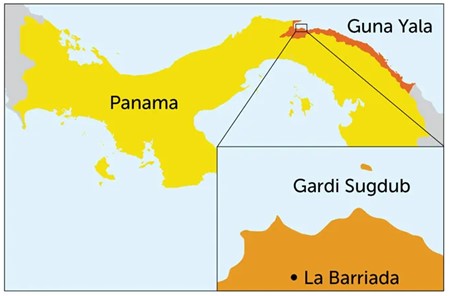
What's happening in Gardi Sugdub?
- Location and Community: Gardi Sugdub is an island in Panama's Guna Yala province, inhabited by about 1,300 members of the Guna community.
- Sea Level Rise: The Caribbean region, including Panama, is experiencing sea level rise at an average rate of 3 to 4 millimetres per year, expected to accelerate to 1 centimetre per year or more by 2100.
- Flooding: Despite efforts to fortify the island, seawater annually floods houses and streets, particularly in November and December.
- Relocation: The Panamanian government has relocated 300 families to Nuevo Cartí on the mainland, constructing new houses for them.
How are other island nations affected by sea level rise?
- Small Island Developing States (SIDS) are highly vulnerable due to low elevation and reliance on marine resources.
- Examples of Impact: Countries like Tuvalu, the Marshall Islands, and Kiribati are experiencing significant land loss, threatening their cultures and economies. Consequences: Rising sea levels contribute to coastal erosion, salinization of freshwater, and increased vulnerability to extreme weather events such as storm surges and king tides.
How fast is global sea level rising?
- Sea Level : Since 1880, global sea levels have risen approximately 21–24 centimetres, with an accelerating rate in recent decades.
- Causes: Global warming, thermal expansion of seawater, and melting of land-based ice (glaciers and ice sheets) are primary drivers.
- Global Temperature Increase: The average global temperature has risen by at least 1.1 degrees Celsius since 1880, further contributing to rising sea levels.

Way forward:
- Strengthen Coastal and Environmental Defences:
- Implement seawalls, breakwaters, and other barriers to protect against storm surges and coastal erosion.
- Restore and conserve natural coastal barriers like mangroves, coral reefs, and wetlands to enhance natural protections.
- Develop and Implement Climate Adaptation Strategies:
- Establish comprehensive climate adaptation plans that include strategies for relocating vulnerable communities and adapting to changing environmental conditions
|
UPSC Civil Services Examination, Previous Year Question (PYQ) Mains Q:1 Explain the causes and effects of coastal erosion in India. What are the available coastal management techniques for combating the hazard? (2022) |
Source: IE
Motor Neuron Disease (MND)
Why in the news?
- Recently, the annual conference on Motor Neuron Disease (MND) ‘Awareness, Care and Management’ was held at NIMHANS.
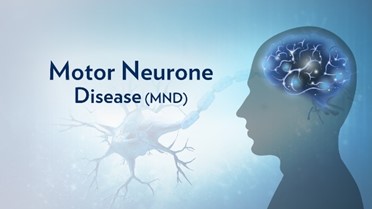
What is Motor Neuron Disease (MND)?
- Motor Neuron Disease (MND) is a condition that affects the nerves in the brain and spinal cord responsible for controlling muscles. O
- Over time, these nerves (motor neurons) stop working properly, leading to muscle weakness and wasting away.
Types of MND:
- Amyotrophic Lateral Sclerosis (ALS):
- Affects both upper and lower motor neurons, leading to weakness in various body parts.
- Progressive Bulbar Palsy (PBP):
- Affects the nerves in the brainstem.
- Leads to problems with speaking and swallowing.
- Progressive Muscular Atrophy (PMA):
- Affects only the lower motor neurons.
- Causes muscle weakness and wasting.
- Primary Lateral Sclerosis (PLS):
- Affects only the upper motor neurons.
- Causes stiffness and movement difficulties.
Causes of MND:
- Genetic Factors: In some families, MND can be inherited due to specific gene mutations.
- Environmental Factors: Exposure to certain toxins, viruses, or physical injuries might contribute, though this is less clear.
- Age and Gender: Usually affects people between the ages of 50 and 70 and is slightly more common in men.
Symptoms:
- Muscle Weakness: Starts in one part of the body, like an arm or leg, and gradually spreads.
- Muscle Cramps and Twitching: Small, involuntary muscle movements.
- Difficulty Speaking and Swallowing: Due to weakness in the muscles used for these functions.
- Breathing Problems: In advanced stages, muscles that control breathing can be affected.
- Emotional Changes: Some people might experience changes in behaviour or thinking.
Diagnosis:
- Clinical Examination: A doctor examines your symptoms and medical history.
- Electromyography (EMG): Tests the electrical activity of your muscles.
- Nerve Conduction Studies (NCS): Checks how well your nerves send signals.
- MRI: Scans to rule out other conditions.
- Genetic Testing: To check for inherited forms of MND.
Treatment:
- There is no cure for MND, but treatments can help manage symptoms and improve quality of life.
Medications:
- Riluzole: Can slow down the progression of ALS.
- Edaravone: Another drug that may slow down the decline in daily activities.
- Symptomatic Treatments: For muscle cramps, excess saliva, and emotional symptoms.
Therapies:
- Physical Therapy: Helps maintain muscle strength and mobility.
- Occupational Therapy: Aids in performing daily activities.
- Speech Therapy: Assists with speech and swallowing difficulties.
- Respiratory Therapy: Supports breathing issues.
|
National Institute of Mental Health and Neuro-Sciences (NIMHANS):
History:
Governance:
Funding:
Outreach:
|
Source: DH
Denmark has taxed cattle burps and farts
Why in the news?
- Recently, Denmark has announced plans to impose a tax on livestock farmers for greenhouse gases (GHGs) emitted by their cows, sheep, and pigs starting in 2030.
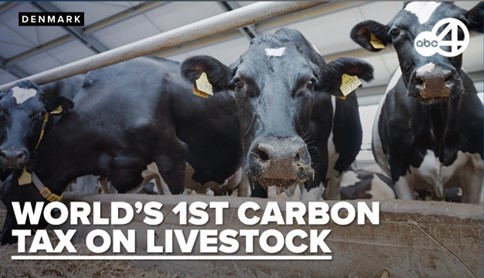
Key Points:
- Tax Rates:
- Initially set at approximately $43 per metric ton of carbon dioxide equivalent emitted by livestock, rising to around $108 by 2035.
- However, due to a 60% income tax deduction, the actual cost per ton will start at 120 kroner ($17.3) and increase to 300 kroner ($43) by 2035.
- Use of Tax Funds:
- Funds collected from the tax between 2030 and 2031 will be reinvested in the industry to support its transition towards more sustainable practices.
- The allocation of proceeds will be reassessed in 2032, with plans including the development of over 600,000 acres of new forest areas.
Why Cows and Sheep Produce Methane:
- Ruminant Digestive System: Animals like cows and sheep produce methane during digestion in their specialised four-compartment stomachs, particularly in the rumen where fermentation of food produces methane.
Methane Emissions Impact:
- Climate Impact: Methane is a potent greenhouse gas, responsible for 30% of global warming since preindustrial times and significantly more potent than carbon dioxide over a 20-year period.
- Health Concerns: Methane contributes to ground-level ozone formation, which can cause respiratory issues and other health problems, contributing to approximately 1 million premature deaths annually.
- Recent Trends: Atmospheric methane levels have been rising, with record increases reported by NOAA in recent years.
Way Forward:
- Dietary Adjustments: Implement feed additives such as seaweed or natural supplements to reduce methane emissions from ruminants without compromising their health or productivity.
- Manure Management: Enhance manure management practices like anaerobic digestion to capture methane emissions from animal waste and convert them into biogas, providing a renewable energy source while mitigating emissions.
- Denmark's initiative: It reflects a proactive approach to addressing livestock-related methane emissions, aiming to balance environmental impact with sustainable agricultural practices.
|
UPSC Civil Services Examination, Previous Year Question (PYQ) Mains Q:1 Describe the major outcomes of the 26th session of the Conference of the Parties (COP) to the United Nations Framework Convention on Climate Change (UNFCCC). What are the commitments made by India in this conference? (2021) |
Source: IE
INSTC Sees First Russian Coal Trains Bound for India
Why in the News?
- Recently, Russia has sent two trains laden with coal to India via the eastern branch of the International North-South Transport Corridor (INSTC) for the first time, according to reports. The trains will transport coal to Bandar Abbas Port in Iran.
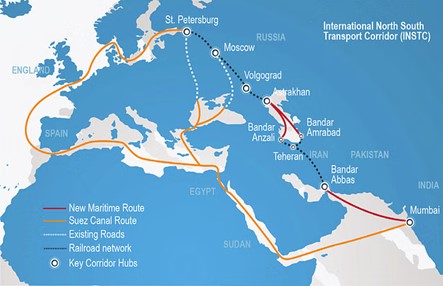
About INSTC:
- Description: INSTC is a 7,200-km multimodal transportation network that links the Indian Ocean to North Europe via Iran and Russia's Saint Petersburg.
- Objective: Designed to enhance trade and transport connectivity among member countries along its route.
- Founding: Envisaged in 2000 by Iran, Russia, and India. Currently, it includes 13 member countries such as Azerbaijan, Armenia, etc., with Bulgaria as an Observer State.
- Corridors: INSTC comprises three main corridors: Central, Western, and Eastern.
Importance of INSTC for India:
- Enhanced Connectivity to Central Asia: Provides easier and more cost-effective transport facilities, reducing transit times significantly.
- Alternative to Suez Canal: Offers an alternative trade route that reduces transit times from around 45 days via the Suez Canal to about 25 days, and cuts freight costs by approximately 30%.
- Energy Security: By bypassing vulnerable chokepoints like the Red Sea and Strait of Hormuz, INSTC enhances India's access to energy resources in Central Asia, the Arctic, Nordic, and Baltic regions.
- Strategic Considerations: INSTC also serves as a strategic counter to the China-led Belt and Road Initiative (BRI) by offering alternative connectivity and trade routes.
|
UPSC Civil Services Examination, Previous Year Question (PYQ) Prelims Q:1 What is the importance of developing Chabahar Port by India? (2017) (a) India’s trade with African countries will increase enormously. (b) India’s relations with oil-producing Arab countries will be strengthened. (c) India will not depend on Pakistan for access to Afghanistan and Central Asia. (d) Pakistan will facilitate and protect the installation of a gas pipeline between Iraq and India. Ans: (c) |
Source: ET
Reasi & the Years-Old Issue of Cross-Border Terror
- The Reasi terrorist attack on June 9, coinciding with Prime Minister Modi's third-term oath-taking ceremony, brings back memories of a similar attack on the Consulate General of India in Herat, Afghanistan, on May 23, 2014.
- Both incidents aimed to disrupt significant political events, revealing the ongoing and pervasive threat of terrorism that India faces, particularly from groups based in Pakistan.
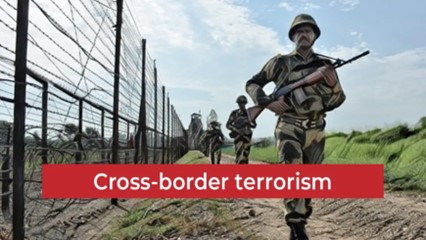
Historical Context of Pakistan-Sponsored Terrorism in India:
- The Origins of Terrorism in Jammu and Kashmir
- The roots of terrorism in J&K can be traced back to the partition of India in 1947, which led to the creation of Pakistan.
- The princely state of Jammu and Kashmir, with its strategic location and diverse demographic composition, became a contentious issue between the two newly formed nations.
- The first Indo-Pak war in 1947-48 resulted in the establishment of the Line of Control (LoC), leaving J&K divided between India and Pakistan.
- The Afghan Jihad and Its Impact
- The success of the Afghan Jihad in the 1980s, where Afghan mujahideen, supported by the United States and Pakistan, successfully resisted the Soviet invasion, had significant repercussions for India.
- Pakistan's military and intelligence agencies, emboldened by this success, believed that similar tactics could be employed to challenge Indian control in J&K.
- This led to the inception of a proxy war strategy, wherein Pakistan began supporting and training Islamist militants to infiltrate J&K and carry out terrorist activities.
- The Insurgency of the Late 1980s and 1990s
- The insurgency in J&K gained momentum in the late 1980s and early 1990s.
- This period saw a significant rise in violence, with separatist groups like the Jammu and Kashmir Liberation Front (JKLF) and later, Islamist militant organisations like Hizbul Mujahideen, receiving substantial support from Pakistan.
- The Pakistani military and intelligence agencies provided training, arms, and logistical support to these groups, facilitating cross-border infiltration.
- During this time, the region witnessed mass uprisings, targeted killings, and ethnic cleansing, particularly against the Kashmiri Pandit community, which led to their mass exodus from the valley.
- The Indian state's initial response was marred by a lack of preparedness and coordination, resulting in significant casualties among civilians and security forces.
- Continued Terrorist Threats and Pakistan's Role
- The Pakistan Army and its political leadership, committed to the Kashmir cause, continued to sponsor and support terrorist activities in the region.
- High-profile attacks, such as the 1999 Kargil intrusion and the 2001 attack on the Indian Parliament, underscored the persistent and evolving nature of the threat.
- The Kargil conflict, in particular, highlighted the extent to which Pakistan was willing to escalate tensions. Regular Pakistani troops, disguised as militants, infiltrated Indian positions in Kargil, leading to a full-scale conflict.
- India’s decisive military response, reclaiming the occupied territories, demonstrated its resolve to protect its sovereignty.
India’s Counter-Terrorism and Political Strategies
- Early Responses and Challenges
- In the late 1980s and early 1990s, India was ill-prepared to handle the sudden surge in terrorist activities in J&K.
- The initial response was largely reactive, with conventional police forces and under-prepared military units bearing the brunt of the attacks.
- The complexity of the insurgency, characterised by guerrilla warfare, hit-and-run tactics, and widespread local support for militants, posed severe challenges.
- During this period, India faced significant casualties among civilians and security forces, and there were instances of human rights violations, which further complicated the situation.
- Development of Counter-Insurgency Strategies
- By the early 1990s, India began to develop more sophisticated counter-insurgency strategies.
- This included the creation of specialised units like the Rashtriya Rifles and the strengthening of paramilitary forces such as the Central Reserve Police Force (CRPF) and Border Security Force (BSF).
- These forces received specialised training in counter-terrorism operations, intelligence gathering, and urban warfare.
- The Indian Army also played a crucial role in these efforts, conducting operations to flush out militants from their strongholds and secure key regions.
- The establishment of the Unified Headquarters in Srinagar helped coordinate efforts between the Army, paramilitary forces, and the J&K police, leading to more effective operations.
- Intelligence and Surveillance Enhancements
- Improving intelligence capabilities became a priority for India and the Research and Analysis Wing (RAW) and the Intelligence Bureau (IB) were tasked with gathering actionable intelligence on militant activities, both domestically and internationally.
- Enhanced surveillance technologies, including the use of drones, satellite imagery, and electronic surveillance, were deployed to monitor infiltration attempts along the Line of Control (LoC) and track militant movements within J&K.
- Socio-Political Engagement and Development Initiatives
- Recognising that a purely military approach would not suffice, the Indian government also focused on political engagement and socio-economic development in J&K.
- The decision to hold Assembly elections in 1996 marked the beginning of efforts to restore democratic governance and political normalcy in the region.
- These elections were a significant step towards involving local populations in the political process and reducing the appeal of militant ideologies.
● Pakistan’s Commitment to the ‘Terror Cause’:
- The Pakistan Army and political leaders: The Pakistan Army and political leaders like Nawaz Sharif and Benazir Bhutto supported J&K separatism through terror.
- Bhutto’s stance in 1994: Benazir Bhutto refused to engage in talks with India in 1994 unless India addressed J&K on Pakistan’s terms, leading to no dialogue during her tenure.
- Sharif’s 1997 initiative: Nawaz Sharif, during his second term as Prime Minister in 1997, sought a structured dialogue with India focusing on humanitarian issues and conflict resolution, with J&K as a priority.
The Change in India’s Stance on Pakistan-Sponsored Terrorism:
- Shift Towards Military Pre-emption
- India's departure from diplomatic restraint occurred after the 2019 Pulwama attack, leading to the Balakot airstrike and the doctrine of pre-emption.
- Earlier, limited force was used in surgical strikes post-Uri attack in 2016. These actions marked a shift towards pre-emptive strikes against imminent terrorist threats.
- However, defining what constitutes an "unacceptable" attack remains ambiguous.
- Pak-Sponsored Terror and India's Diplomatic Efforts:
- India too has given material linking Pakistani terrorist groups to terrorist incidents but Pakistan has not taken action against them.
- After the 2001 Parliament attack, the A.B. Vajpayee government mobilised the armed forces but refrained from war due to assurances from Pakistan’s President Pervez Musharraf.
- After the 2008 Mumbai terrorist attack, Dr. Manmohan Singh opted for global diplomatic support rather than military action.
- This was clear after the Mumbai terrorist attack. After the Pathankot airbase attack in January 2016, India allowed a Pakistani team which included an Inter-Services Intelligence officer to visit the airbase. After the Pulwama attack in 2019, India launched the Balakot aerial strike and announced a doctrine of pre-emption. However, Pakistan again did not take the investigation forward.
● International Recognition and Diplomatic Efforts:
- Major powers’ recognition: Major powers recognize Pakistan’s use of terrorism against its neighbours.
- Plausible deniability: Despite plausible deniability, Pakistan’s actions are increasingly unsustainable.
- Evidence linking attacks to Pakistani groups: India has provided evidence linking Pakistani terrorist groups to various attacks, but Pakistan has failed to act.
- Post-Reasi attack emphasis: After the Reasi attack, External Affairs Minister S. Jaishankar emphasised the need to address cross-border terrorism and its escalation risks between nuclear-armed countries.
- Despite these cases, it is important to pursue the practice of sharing information and evidence in terrorist cases to ensure the credibility of Indian assertions with the international community.
Conclusion:
Hence, the persistent threat of terrorism from Pakistan requires India to balance military responses and diplomatic efforts. External Affairs Minister S. Jaishankar's ambition to address cross-border terrorism highlights the need for global recognition of the terror threat as a precursor to escalatory conflicts between nuclear-armed nations. India’s strategy must continue to evolve, combining force with diplomacy to mitigate terrorism and promote regional stability.
|
UPSC Civil Services Examination, Previous Year Questions (PYQs) Mains Q:1 Analyse the complexity and intensity of terrorism, its causes, linkages and obnoxious nexus. Also suggests measures required to be taken to eradicate the menace of terrorism. (UPSC IAS/2021) Q:2 The Indian government has recently strengthened the anti-terrorism laws by amending the Unlawful Activities (Prevention) Act, (UAPA), 1967 and the NIA Act. Analyse the changes in the context of the prevailing security environment while discussing the scope and reasons for opposing the UAPA by human rights organisations. (UPSC IAS/2019) |
Source: TH
Share the article
Edukemy’s Current Affairs Quiz is published with multiple choice questions for UPSC exams
MCQ
Get Latest Updates on Offers, Event dates, and free Mentorship sessions.

Get in touch with our Expert Academic Counsellors 👋
FAQs
UPSC Daily Current Affairs focuses on learning current events on a daily basis. An aspirant needs to study regular and updated information about current events, news, and relevant topics that are important for UPSC aspirants. It covers national and international affairs, government policies, socio-economic issues, science and technology advancements, and more.
UPSC Daily Current Affairs provides aspirants with a concise and comprehensive overview of the latest happenings and developments across various fields. It helps aspirants stay updated with current affairs and provides them with valuable insights and analysis, which are essential for answering questions in the UPSC examinations. It enhances their knowledge, analytical skills, and ability to connect current affairs with the UPSC syllabus.
UPSC Daily Current Affairs covers a wide range of topics, including politics, economics, science and technology, environment, social issues, governance, international relations, and more. It offers news summaries, in-depth analyses, editorials, opinion pieces, and relevant study materials. It also provides practice questions and quizzes to help aspirants test their understanding of current affairs.
Edukemy's UPSC Daily Current Affairs can be accessed through:
- UPSC Daily Current Affairs can be accessed through Current Affairs tab at the top of the Main Page of Edukemy.
- Edukemy Mobile app: The Daily Current Affairs can also be access through Edukemy Mobile App.
- Social media: Follow Edukemy’s official social media accounts or pages that provide UPSC Daily Current Affairs updates, including Facebook, Twitter, or Telegram channels.


